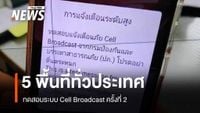The Department of Disaster Prevention and Mitigation (DDPM) is set to conduct a second round of testing for its "Cell Broadcast System" today, May 7, 2025, at 1:00 PM in five designated areas across Thailand. This initiative aims to enhance the country’s disaster alert capabilities, ensuring that citizens receive timely warnings in the event of emergencies.
Today’s tests will take place in the following locations: Lamphang, Nakhon Sawan, Nakhon Ratchasima, Suratthani, and the Din Daeng district of Bangkok. Each test will involve sending emergency alerts directly to mobile phones within an 8-kilometer radius of the specified areas. The alerts will include a warning sound lasting approximately eight seconds, accompanied by a message displayed in both Thai and English.
According to the DDPM, the message will read: "This is a test message from DDPM. No action required." This statement is intended to reassure the public that the alert is merely a test and not indicative of any actual emergency. The department emphasizes that there will be no links attached to these messages and urges the public to remain vigilant against potential scams.
The first round of testing occurred on May 2, 2025, and was part of a broader effort to implement the Cell Broadcast System effectively. During the initial test, various scenarios were observed regarding how mobile phones responded to the alerts. For example, if a phone was turned off, in silent mode, or set to airplane mode, it would still receive the alert. However, phones that were completely off did not receive any notifications.
The DDPM has highlighted the importance of this system, particularly in regions prone to natural disasters, such as floods and earthquakes. By utilizing the Cell Broadcast System, authorities aim to ensure that critical information reaches citizens quickly and efficiently.
In addition to today’s test, a larger scale test is scheduled for May 13, 2025, at 1:00 PM, which will cover provinces including Chiang Mai, Ayutthaya, Udon Thani, and Nakhon Si Thammarat, alongside Bangkok. This phased approach allows the DDPM to assess the system’s effectiveness and make necessary adjustments before full implementation.
During the trials, the DDPM has been collecting data on how well the alerts are received by different devices and under various conditions. Reports from the first test indicated that while some mobile phones vibrated and produced sound alerts, others failed to do so, depending on their settings at the time of the alert. This inconsistency has raised concerns about ensuring that all devices can effectively receive alerts in the future.
As part of the testing protocol, the DDPM has advised users not to panic when they receive the alert. They have reiterated that the system is designed to improve public safety and that the alerts are a crucial component of disaster preparedness. The department has also warned against responding to any suspicious messages that may appear to mimic the official alerts.
Today’s testing is a critical step in enhancing Thailand’s emergency response capabilities. With climate change leading to an increase in the frequency and severity of natural disasters, the need for an effective communication system has never been more pressing. The DDPM’s efforts to implement the Cell Broadcast System reflect a proactive approach to safeguarding lives and property.
Residents in the designated areas are encouraged to participate in the test by ensuring their mobile devices are on and ready to receive alerts. The DDPM hopes that this initiative will not only improve the efficiency of emergency communications but also raise public awareness about disaster preparedness.
As the tests continue, the DDPM will analyze the results to refine the system further. Feedback from the public will also be taken into account as they work towards a fully operational Cell Broadcast System that can be relied upon during actual emergencies.
In conclusion, the Cell Broadcast System represents a significant advancement in Thailand’s disaster management framework. By effectively notifying citizens of impending dangers, the DDPM aims to mitigate risks and enhance community resilience in the face of natural disasters.





